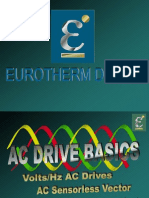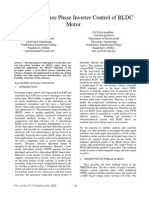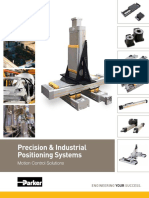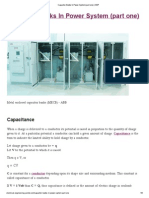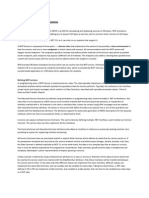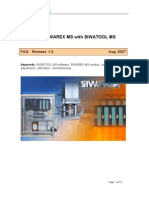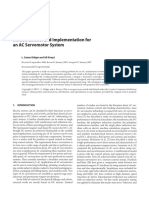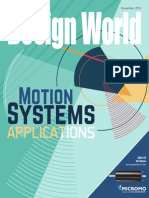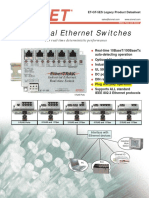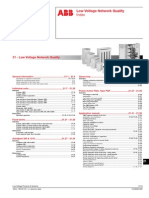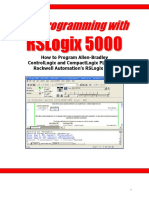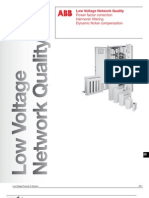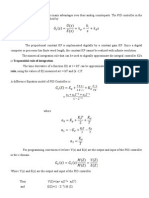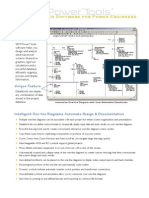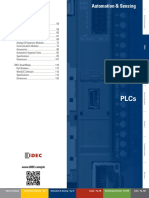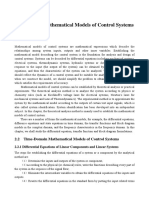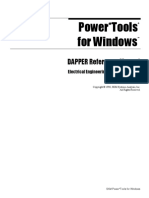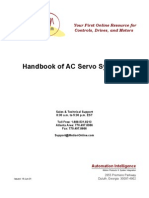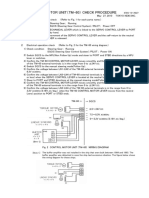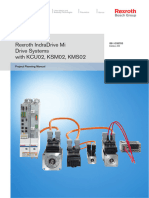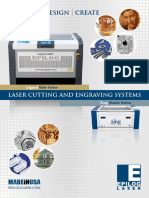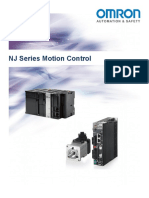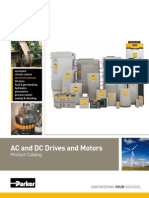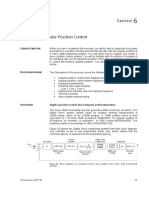AC Servo Systems
AC Servo Systems
Uploaded by
Le Hai DangCopyright:
Available Formats
AC Servo Systems
AC Servo Systems
Uploaded by
Le Hai DangCopyright
Available Formats
Share this document
Did you find this document useful?
Is this content inappropriate?
Copyright:
Available Formats
AC Servo Systems
AC Servo Systems
Uploaded by
Le Hai DangCopyright:
Available Formats
<RXU#)LUVW#2QOLQH#5HVRXUFH#IRU ###############################################&RQWUROV/#'ULYHV/#DQG#0RWRUV
Handbook of AC Servo Systems
Sales & Technical Support 8:30 a.m. to 5:30 p.m. EST Toll Free: 1.888.531.8213 Atlanta Area: 770.497.8086 Fax: 770.497.8666 Support@MotionOnline.com
Automation Intelligence
Motion Products System Integration
02/11/00
Issued: 11-Feb-00
2855 Premiere Parkway, Suite A Duluth, Georgia 30097-4902
Handbook of AC Servo Systems
www.MotionOnline.com
7DEOH#RI#&RQWHQWV
Page
1. Introduction .............................................................. 2. How does the DC Servo Motor Produce Torque? ...................
2.1. Cascade Control Structure 2.2. Torque Production with a DC Servo Motor
3 4
3. How does the AC Servo Motor Produce Torque? ...................
3.1. History of Brushless Servo Systems 3.2. Torque Production with an AC Servo Motor
4. Overview of the AC Servo System .
4.1. 4.2. 4.3. 4.4. 4.5. 4.6. Introduction The AC Servo Motor The Position Sensor The Current Controlled Power Converter The Velocity Regulator The Position Regulator
10
5. How to Size and Apply the AC Servo System ...
5.1. Basics of Sizing a Servo System 5.2. Mechanical Transmissions 5.2.1. Timing Belts 5.2.2. Gear Reducers 5.2.3. Leadscrews 5.2.4. Tangentially Driven Loads 5.2.5. Relationships for Common Shapes 5.2.6. Mechanical Transmission Requirements 5.3. Regeneration Considerations 5.4. Transformer Considerations 5.5. Electrical Noise Considerations
25
6. General Information .
6.1. Engineering Unit Conversion Tables, Formulae, & Definitions 6.2. FaxBack Sizing Worksheet
40
7. References .
42
Issued: 11-Feb-00
Copyright 1998-2000 Automation Intelligence, Inc.
Page 2
Handbook of AC Servo Systems
www.MotionOnline.com
,QWURGXFWLRQ
The Automation Intelligence Story Automation Intelligence is a growth-oriented, privately held corporation, which started in 1983 as a control system integrator. We have specialized in designing and implementing high-speed machine controls with a particular emphasis on servo-driven machinery. Our early years focussed on machine controls for the packaging machinery industry. Inspired by deficiencies in commercially available motion controls, and foreseeing the massive market trend for PC-based machine controls, Automation Intelligence developed a software-based multi-axis motion control product that is called AML. Since its introduction in 1992, AML has been steadily advanced and applied in a large variety of general-purpose multi-axis machine control applications including packaging, printing, painting, winding, converting, material handling, and many other types of specialty machines. In late 1997, Sanyo Denki purchased Automation Intelligence shortly after completing a licensing agreement for AML products. Sanyo Denki and Automation Intelligence share a vision for openarchitecture control of factory machinery. Under Sanyo Denki ownership, Automation Intelligence is increasing investments in the advancement of AML and, as always, Automation Intelligence will keep close to the real world by continuing our 17 year history of control system integration. Why This Handbook? Automation Intelligence has also recognized the rapid increase in application of servo products and the emergence of many small to medium volume users that have extensive application experience. However, these knowledgeable users must purchase servo systems from traditional distribution channels that are structured to provide considerable value-added assistance (which many experienced users no longer need). MotionOnline.com is a new sales channel, which can allow the experienced servo system users to purchase world-class Sanyo Denki products directly from Automation Intelligence at prices comparable to the high-volume users. This handbook, which is authored by the employees of Automation Intelligence, is a way of sharing our accumulated experience and technical know-how. It is our desire to promote the continued growth of servo systems on industrial machinery. How To Use This Handbook? This handbook is divided into two basic segments. Chapters 2-4 focus on a review of the theory and operation of ac servo systems while chapters 5-6 focus on the application of ac servo systems. Please feel free to provide your feedback as we plan to periodically update and expand the practical information found in this handbook.
Issued: 11-Feb-00
Copyright 1998-2000 Automation Intelligence, Inc.
Page 3
Handbook of AC Servo Systems
www.MotionOnline.com
+RZ#GRHV#WKH#'HUYR#0RWRU 3URGXFH#7RUTXH"
Understanding the operation of a high performance dc servo system is an excellent place to begin before we proceed with a discussion of the ac servo system. The control structure for a dc servo system is identical to the ac servo system and the principle of torque production in a dc servo motor will be used to draw the close parallel to torque production in the ac servo motor. 2.1 Cascade Control Structure The most common structure of a high performance dc servo system is shown in Figure 1. There is virtually universal agreement that the cascaded control structure is the most effective approach to high performance servo systems. The cascade control structure includes an innermost current (or torque) regulator, a speed regulator around the current (or torque) regulator, and an outermost position regulator around the speed regulator. The sequence of position, speed, and current (torque) is natural as it matches the structure of the process to be controlled. Position is the integral of speed while speed is proportional to the integral of torque. The 4 quadrant power supply just means that the power converter can handle operation of the motor for all combinations of torque (current) and speed (voltage). The cascade control structure will operate properly only if the bandwidth of the various regulators have the correct relationship. Bandwidth is the range of frequencies over which the controlled quantity tracks and responds to the command signal. In the cascade control, the current regulator has the highest bandwidth, then the speed regulator, and finally the position regulator has the lowest bandwidth. Therefore, the system is properly adjusted beginning with the innermost current regulator and working outward to the position regulator. The cascade control structure also has the benefit of easily limiting each variable by just limiting the commanded value for that variable.
AC Supply
Desired Position
Position Regulator
Max
Speed Regulator
Max
Current Regulator
Voltage
Current Sensor
II I Braking Motoring
Current
DC Motor
Position Feedback
Min
Speed Feedback d dt
Min
Current Feedback
III IV Motoring Braking
4 Quadrant Power Supply Position Sensor
Figure 1. Cascade Control Structure of High Performance DC Servo System
Issued: 11-Feb-00
Copyright 1998-2000 Automation Intelligence, Inc.
Page 4
Handbook of AC Servo Systems
www.MotionOnline.com
2.2 Torque Production with a DC Servo Motor
Understanding the principle of torque production with a dc servo motor (brush-type servo motor) is an excellent foundation for the later discussion of torque production with an ac servo motor (brushless servo motor). Please refer to the representation of a dc servo motor with a mechanical commutator as shown in Figure 2.
IA Represents Mechanical Commutator (the black bar is the brush)
Current out of page Current into page
Permanent Magnet Field
Magnetic Field Vector
T = 90
Torque
IA = Armature Current
Armature Current Vector
Figure 2. DC Servo Motor Principle of Operation
The magnetic field created by the permanent magnets is fixed in space and is represented by the vector labeled Magnetic Field Vector. A torque is produced by the interaction of the magnetic field and the current-carrying conductors. The torque is a maximum value when the magnetic field vector is perpendicular to the Armature Current Vector. The magnitude of the torque is described by the equation: Torque = K B IA sinT where K is a constant determined by the specific motor design, B is the magnetic flux density, IA is the armature current and T is the angle between the two vectors (the torque angle). The motor torque produced by the interaction of the current-carrying conductors in the magnetic field will cause rotation of the rotor until the torque angle is zero degrees and further motion would not be possible. The dc servo motor eliminates this condition by using a mechanical commutator on the rotor. The commutator causes the current in each conductor to be progressively reversed as the conductor connected to a commutator bar passes beneath the brushes. The physical location of the brushes in a dc servo motor is such that the torque angle is 90 degrees for both directions of rotation. The result is torque generation that is proportional to armature current.
Issued: 11-Feb-00
Copyright 1998-2000 Automation Intelligence, Inc.
Page 5
Handbook of AC Servo Systems
www.MotionOnline.com
The classic equations that describe the dc servo motor are as follows: Torque = KT IA EG = BEMF Voltage = KE nM where KT is the torque constant, KE is the voltage constant, BEMF is back electro-motive force, and nM is the motor speed. The speed voltage EG is created by the armature conductors moving through the constant magnetic field. EG is referred to as BEMF (back electro-motive force) or CEMF (counter electromotive force) because the polarity is such that it will produce armature current that will interact with the magnetic field in such a way as to oppose motion. The complete block diagram for the dc servo motor including the armature resistance and inductance is shown below in Figure 3. Now we can see how the torque of a dc servo motor can be easily adjusted by accurately and rapidly controlling the armature current.
RA = armature resistance RA LA LA = armature inductance
IA
EG Permanent Magnet Field
BEMF
nM = motor speed TM = motor torque JM = motor moment of inertia
Figure 3. DC Servo Motor Block Diagram
Unfortunately, while the control of torque with the dc servo motor is very straightforward, the mechanical commutator introduces many limitations. Some of these limitations include: i i i i i i periodic maintenance due to brush wear and brush replacement RFI (radio frequency interference) caused by brush arcing voltage (speed) and current (torque) limits caused by the mechanical commutation process higher rotor inertia due to armature windings and commutator located on the rotor a poor thermal situation due to I R losses in the armature windings on the rotor and the cost of the commutator system which needs to be very precise.
2
The ac servo system with an electronic commutator was developed to eliminate the limitations of the dc servo motors mechanical commutator.
Issued: 11-Feb-00
Copyright 1998-2000 Automation Intelligence, Inc.
Page 6
Handbook of AC Servo Systems
www.MotionOnline.com
+RZ#GRHV#WKH#$HUYR#0RWRU 3URGXFH#7RUTXH"
3.1 History of Brushless Servo Systems The permanent magnet dc servo system or brush-type servo has served as the industry workhorse for many decades. While it is straightforward to control torque with a permanent magnet dc servo motor, the mechanical commutator introduces many serious limitations as listed in the previous section. The brushless servo system was developed to eliminate the limitations imposed by the mechanical commutator of a dc servo system. The first implementation of a brushless servo system used three-phase permanent magnet motors and square-wave or rectangular shaped currents. The back EMF waveform of the brushless motors ranged from sinusoidal to trapezoidal. The basic idea was to emulate the brush-type dc servo motor by electronically commutating the current from one pair of motor windings to another. Completing the analogy with a brush-type servo system, the motor-mounted feedback devices for a velocity controlled brushless servo system included a commutation encoder and brushless tachometer. The commutation encoder provided the position signals used to transition the current electronically from one pair of windings to another. The analogy to the dc servo system resulted in names for these early brushless servo systems such as brushless dc servo, ECM (electronically commutated motor), six-step servo, and trapezoidal brushless servo. With careful design, these early brushless servo systems had good performance and they demonstrated the possibility for replacing the brush-type servo motor with a brushless servo motor. However, the design challenges and extra cost of these early brushless servo systems limited application to larger power levels and situations where the extra cost could be justified. This early type of brushless servo is rarely used today in high performance servo systems. Fortunately, the analogy to a dc servo system can also be extended to sinusoidal current excitation of a permanent magnet motor with sinusoidal back EMF. This technology is commonly referred to as field-oriented or vector control. Compared to the first generation of brushless servo systems with square-wave currents, a brushless servo system with sinusoidal back EMF and sinusoidal current is much more practical to manufacture and inherently has much smoother torque production due to the gradual commutation process. This type of brushless servo system is commonly referred to as an ac servo, PM (permanent magnet) ac servo, or sinusoidal brushless servo. For the remainder of this handbook, we will refer to this state-of-the-art brushless servo system as an ac servo system. The field-oriented or vector control can also be extended to ac induction motors. Variable speed drives (VSDs) with this technology are referred to as vector drives. Vector drives can be applied as servo drives but the induction motors do not have the performance of the permanent magnet ac servo motors due to higher inertia and larger size. However, vector drives are adequate for some servo applications (particularly larger power applications where permanent magnet ac servo systems are not readily available). The details of vector control for ac induction motors will not be discussed further in this handbook.
Copyright 1998-2000 Automation Intelligence, Inc.
Issued: 11-Feb-00
Page 7
Handbook of AC Servo Systems
www.MotionOnline.com
3.2 Torque Production with an AC Servo Motor The best way to understand the principle behind the ac servo system is to develop an analogy to the dc servo system. As discussed earlier, the dc servo motor has a magnetic field that is fixed in space and the mechanical commutator causes the armature current vector to be perpendicular to the field vector at any motor speed or position. The torque produced by the dc servo motor is easily adjusted by controlling the armature current level. As we will soon see, we have an analogous method for controlling the torque of an ac servo motor using vector or field-oriented control. Lets start with the magnetic field of the ac servo motor. Figure 4 shows a simple representation of an ac servo motor with a permanent magnet rotor and three-phase stator where the windings are spaced by 120 degrees. The magnetic field vector established by the permanent magnets is labeled B. Unlike the dc servo motor where the permanent magnets are stationary, the magnets of the ac servo motor move as they are mounted on the rotor. The challenge of the field-oriented control strategy is to generate the three-phase stator currents in such a way as to keep the composite current vector perpendicular to the magnetic field vector at all times.
Figure 4. AC Servo Motor with Permanent Magnet Field and Three-Phase Stator Now lets review the generation of the composite current vector using Figure 5. The three-phase stator currents are represented as three sine waves that are displaced in space by 120 degrees with axes labeled as U, V, and W. As examples, the composite current vector is developed for angles of 60 and 90 degrees. Notice for every angle that the composite current vector has a magnitude equal to 1.5IT where IT is the amplitude of the phase currents and 1.5IT has an angular position equal to the angle G.
G = 60o W
0
o
W 1.5IT
G = 90
IT
1.5IT U U
120o 240o
G
360o
G = 60
V
G = 90
V
IV
IW
IU
Figure 5. Current Vector for Three-Phase AC Servo Motor
Issued: 11-Feb-00
Copyright 1998-2000 Automation Intelligence, Inc.
Page 8
Handbook of AC Servo Systems
www.MotionOnline.com
Lets stop and review. We have a fixed amplitude magnetic field vector created by the permanent magnets that rotates synchronously with the rotor of the motor. We also have a composite current vector that rotates at the angular frequency of the phase currents and has an amplitude that is proportional to the peak value of the sinusoidal phase currents. Maybe you can see that we have our answer on how to simply control the torque of the ac servo motor. Let the angle of the motor rotor be called G and let G be the angular frequency of the sinusoidal 0 phase currents. Then, we just establish G = 0 so that the current vector is perpendicular to the magnetic field vector. In practice, this is accomplished by physically orienting the rotor position sensor (usually an encoder or a resolver) so that the composite current vector is perpendicular to the magnetic field vector. Actually, the motor BEMF signal is easier to measure and is uniquely related to the magnetic field vector so the position feedback device is oriented to the BEMF signals during the manufacturing process. In this way, no matter what motion the rotor might make, the current vector will always be perpendicular to the magnetic field vector. We now have an ac servo system where the torque can be controlled just like the dc servo system and where the ac servo motor looks just like the dc servo motor to the speed and position regulators. Lets draw a picture of the vector control for an ac servo motor as shown in Figure 6.
B T = 90o IT G
Permanent magnets on the rotor create a field vector that rotates synchronously with the rotor of the motor Composite current vector is located perpendicular to the field vector at all times by locking the angular frequency of the three phase stator currents to the properly defined rotor angle G Torque is then directly proportional to the amplitude of the three-phase sinusoidal currents
B Vector T = 90o
Field vector is fixed in space by the stationary permanent magnets Current vector is located perpendicular to the field vector by proper location of the brushes on the commutator Torque is then directly proportional to the armature current
TM = KT IT AC Servo System
TM = KT IA
IA Vector DC Servo System
AC Supply
Desired Position
Position Regulator
Max
Speed Regulator
IT ITsinG ITsin(G-120o) ITsin(G-240o)
Current Sensors
Permanent Magnet AC Motor
Electronic Commutator
Max
Position Feedback
Min
Speed Feedback d dt
Min
Torque = KT IT
Position of Rotor
Current Controlled Power Converter
Position Sensor
Figure 6. Cascade Control Structure of the High Performance AC Servo System with Field-Oriented Control
Issued: 11-Feb-00
Copyright 1998-2000 Automation Intelligence, Inc.
Page 9
Handbook of AC Servo Systems
www.MotionOnline.com
2YHUYLHZ#RI#WKH#$HUYR#6\VWHP
4.1 Introduction The purpose of this section is to review some of the theory behind the major components of an ac servo system. Figure 7 repeats the block diagram of the ac servo system and highlights the five areas of discussion (with section number). The digital ac servo system is typically available with three modes of operation: Torque Control Mode Analog input is the current command signal which we know from earlier discussions is proportional to motor torque. No tuning is required but some adjustment may be required to scale the analog input to current or torque. Velocity Control Mode Analog input is the velocity command. The velocity regulator is tuned for the motor and load. Position Control Mode Step and Direction (stepper emulation) is the position command. Both the velocity regulator and the position regulator must be adjusted for a specific motor and load.
Torque Control Mode Velocity Control Mode Position Control Mode
AC Supply
4.6
Desired Position Position Regulator
Max
4.5
Speed Regulator IT Current Sensors IU IV IW
4.2
Permanent Magnet AC Motor
Electronic Commutator
Max
Position Feedback
Min
Speed Feedback d dt
Min
Position of Rotor
4.4
Current Controlled Power Converter
Position Sensor
4.3
Figure 7. Block Diagram of AC Servo System
Issued: 11-Feb-00
Copyright 1998-2000 Automation Intelligence, Inc.
Page 10
Handbook of AC Servo Systems
www.MotionOnline.com
4.2 The AC Servo Motor The permanent magnet ac servo motor has a very straight-forward and rugged construction. The stator has three symmetrical windings, which are internally connected in a wye configuration. The neutral connection is not brought outside the motor so only three power wires are available from the motor. Compared to the dc servo motor, the construction of the ac servo motor is thermally more effective because almost all of the losses are in the stator where they can be more easily routed to the outside ambient. The rotor contains the permanent magnets, which can be mounted in different ways depending on a specific suppliers technology. The permanent magnet material ranges from low cost ceramic (ferrite) to the more expensive rare-earth materials such as samarium cobalt or neodymium iron boron (neo). Most recent ac servo motor designs use neo as a good compromise between magnetic properties, availability, and cost. The rotor also includes a rotary position sensor. The multi-purpose position sensor is used for commutation (or generation of the sinusoidal current commands), velocity feedback, and position feedback. The block diagram of an ac servo motor is shown in Figure 8. It is very similar to the block diagram of the dc servo motor in Figure 3 except that the voltage and current values are sinusoidal. The block diagram in Figure 8 is very useful in developing an understanding of the relationship between voltage and current in the ac servo motor.
R = per phase resistance (phase to phase resistance = 2 R) L = per phase inductance (phase to phase inductance = 3 L) R L VUV = Phase to Phase Voltage = 3 VUN
IU VUN Permanent Magnet Field
EG = nM KEI BEMF
nM = motor speed TM = motor torque JM = motor moment of inertia
Figure 8. Per Phase Block Diagram of an AC Servo Motor
The vector control of the ac servo motor allows the phase current to be kept in phase with the BEMF at all times and by controlling the amplitude of the phase current we can adjust the level of motor torque. The voltage relationships and torque-speed curve for an ac servo system are shown in Figure 9 as developed from the ac servo motor block diagram in Figure 8.
Issued: 11-Feb-00
Copyright 1998-2000 Automation Intelligence, Inc.
Page 11
Handbook of AC Servo Systems
www.MotionOnline.com
300%
Peak Torque Limited Peak Torque Limited by Current Limit by Voltage Limit
Torque
200%
Intermittent Operating Region
VR = IU R = voltage across the phase resistance
100%
Continuous Operating Region
0 1000 2000 3000 4500
r.p.m.
EG = KEI nM = back emf voltage (line to neutral)
Vun = required phase to neutral terminal voltage to establish the desired phase current
VL = 2S fe L IU = voltage across the phase inductance where fe = nM(rpm) 1 #poles 60 2
Figure 9. Voltage Relationships and Torque-Speed Curve for AC Servo System The voltage and current relationships are important because they determine the torque-speed operating boundary for the ac servo system. With vector control, the torque is adjusted by the level of phase current and by keeping the phase current in phase with the BEMF. The terminal voltage required to create the necessary phase current can be determined as shown in Figure 9. The current controlled power converter has a maximum available voltage as determined by the ac supply. When the maximum available terminal voltage has been reached due to requested torque (current) or speed, then the phase current can no longer be properly controlled and we no longer have the proper relationship between torque and current. The following equations can be used to calculate the ideal maximum voltage available from the power converter. The actual voltage will be lower due to various voltage drops in the system.
VBUS = DC Bus Voltage = 2 VAC (VAC = AC Supply Voltage) Example: VBUS # 325 VDC = (2) (230 VAC r.m.s. line to line) Maximum VUN = Maximum available line to neutral volts = VBUS (3 2) Example: Maximum VUN = 133 Vrms = 325 (3 2)
Issued: 11-Feb-00
Copyright 1998-2000 Automation Intelligence, Inc.
Page 12
Handbook of AC Servo Systems
www.MotionOnline.com
4.3 The Position Sensor The ac servo motor has a rotary position sensor, which is mounted on the non-drive end of the motor. As we have seen in Figure 6, the position sensor is used for the electronic commutation of current, speed feedback, and position feedback. The most common position sensor used with ac servo motors is the optical incremental encoder. In special cases, where homing the load on power-up is not acceptable, a more costly multi-turn absolute position feedback device is used instead of the incremental encoder. Todays ac servo systems are almost all digital. Optical incremental encoders which provide digital information are easily interfaced to digital servo drives where they offer high resolution and accuracy at an attractive cost. The basic operation of a wire saving incremental encoder is shown in Figure 10. The low resolution absolute position start-up signals are only necessary during power-up to initialize the rotor angle inside the digital servo drive. The high resolution data tracks and marker pulse (C signal) are used after power-up and during normal operation of the system. By using the wire-saving design, the same 6 wires can be used for both start-up and normal operation which minimizes the cost and diameter of the cable running between the drive and motor. Including the dc supply wires, the wire-saving encoder only requires 8 total wires. However, in practice, small gauge wire is used so it is common to double or even triple-up on the supply lines in order to minimize voltage drop over longer cable lengths. As an alternative, some drives use a pair of voltage sensing lines to measure supply voltage at the encoder and then adjust the supply voltage at the drive to maintain the proper voltage at the encoder.
+5 VDC SG
The data signals are present after power-up to precisely measure the rotor angle
Light Source Data (Incremental) Multiplexer
Line Drivers 26LS31 A A Start-up 1 Start-up 1
Start-up 2
Start-Up Signals (Absolute) Coded Disk (usually glass) Power-On Timing Circuit
Start-up 2
Start-up 3
Start-up 3
These signals are present during power-up to initialize the rotor angle
Figure 10. Principle of Operation for a Wire-Saving Incremental Optical Encoder A representation of the signals from the incremental optical encoder is shown in Figure 11. For simplicity, the signals are shown without the complement signals from the line drivers. However, in practice, differential feedback signals are essential to eliminate noise problems and to facilitate long cable lengths.
Issued: 11-Feb-00
Copyright 1998-2000 Automation Intelligence, Inc.
Page 13
Handbook of AC Servo Systems
www.MotionOnline.com
The encoder is attached to the ac servo motor in a very particular and precise way during the assembly of the motor. From earlier discussions, the rotor angle must be defined so that the composite current vector is kept perpendicular to the magnetic field at all times. The start-up signals provide low resolution absolute position information to initialize the rotor angle in the servo drive. The resolution of the start-up signals provide for r 30 degree accuracy of the torque angle. As torque is proportional to the sine of the torque angle, we have at least 86% of maximum torque available to move the load up to one mechanical revolution until we pick-up the C signal or marker pulse. After we detect the marker pulse, the torque angle is set to the exact value necessary for a 90 degree torque angle. The marker pulse has a unique position relative to the start-up signals which is determined by the manufacture of the encoder and which is specified by the supplier of the servo system. The marker pulse also has a unique relationship to the motor BEMF signal and is precisely aligned during the installation of the encoder onto the motor. The accuracy of the marker pulse to the motor BEMF signal is usually at least r 2 mechanical degrees which provides more than 99% of maximum torque for 4, 6, and 8 pole motors. Finally, the A and B data signals typically provide 2000 cycles per mechanical revolution. The servo drive encoder interface circuit is designed to detect all of the edge transitions for the data signals so the 2000 line encoder provides 8000 counts or pulses per revolution (ppr).
360
Mechanical Degrees
Start-Up 1 Start-up 2 Start-up 3
60
120
180
240
300
360
Electrical Degrees Electrical Degrees = (Mechanical Degrees) (Pole Pairs) (example: a 4 pole motor has 2 pole pairs)
Figure 11. Representation of the Incremental Encoder Signals
Issued: 11-Feb-00
Copyright 1998-2000 Automation Intelligence, Inc.
Page 14
Handbook of AC Servo Systems
www.MotionOnline.com
4.4 The Current Controlled Power Converter As discussed earlier, the ac servo motor produces torque which is proportional to the amplitude of the composite current vector. As you can imagine, the ac servo drive must produce current accurately and with high response. This extremely important task is the work of the current controlled power converter as shown in Figure 12.
60 Hz AC Supply
DC Bus Capacitor
Pulse-Width-Modulated (PWM) Inverter
Regeneration Resistor
Voltage Sense & On/Off Control
U Rectifier & Soft Charge Regeneration Circuit Transitor On/Off Signals
W Dynamic Brake Circuit
IU = ITsinG
Current Regulator
Voltage Command
Current Feedback
Triangle Voltage
Lockout Circuitry & Base Drivers
Permanent Magnet AC Motor
Figure 12. Block Diagram of the Current Controlled Power Converter
The system is supplied by the ac mains which typically is required to be single phase or three phase voltage at 230 Vrms (+10%/-15%) and 60 Hz (r 3%). Sometimes the ac supply is buffered by a transformer in order to provide the correct voltage level. The primary attribute of the ac supply is that it needs to maintain the required voltage level even as it is loaded by the servo drive(s) or other items attached to the supply. The diode rectifier converts the ac input into a dc voltage, which is called the dc bus. Included with the diode rectifier is a circuit to control the inrush current(s) during power-up. Without the soft start or soft charge circuit there would be very large inrush currents to charge the dc bus capacitor. After initial power-up, the rectifier circuit is free to provide the necessary energy to the servo system as required.
Issued: 11-Feb-00
Copyright 1998-2000 Automation Intelligence, Inc.
Page 15
Handbook of AC Servo Systems
www.MotionOnline.com
The dc bus capacitor has a large value, which serves two purposes. One purpose is to act as a large filter so that a smooth dc bus voltage is available to the inverter. The second purpose is to help absorb energy during regeneration or braking of the motor and load. While the diode rectifier can supply power during motoring or driving, it cannot return power to the ac supply during braking. The regeneration energy is absorbed by the dc bus capacitor until it charges to a maximum allowable voltage and then the regeneration circuit dumps excess energy in the regeneration resistor where it is eliminated in the form of heat. Most ac servo drives include a small built-in regeneration resistor while having the provision for adding an external resistor with a much larger wattage. The inverter is designed with power switches that are turned on or off. These power switches can be bipolar transistors or power FETs but most ac servo drives today use a newer switch referred to as an IGBT (insulated-gate bipolar transistor). The IGBT combines the rugged output of the bipolar transistor with the gate drive and fast turn-off time of the power FET. The inverter topology, with the six switches and the flyback diodes, provides four quadrant operation of the ac servo motor by allowing energy to flow to and from the motor. Lets take a look at the current controller design for one of the three phases. The other two phases operate in an identical fashion. The desired current or current command is IU and it can be limited to a user defined value (up to a maximum as determined by design limits). The current command is compared to the current feedback to produce a current error. As you can imagine, the current sensors must be very accurate and responsive devices, as they must absolutely produce a faithful reproduction of actual current. The current error is processed by the current regulator to produce the voltage command. The current regulator has a high-gain to minimize the current error over the operating range of the system. The voltage command is compared to a triangle voltage to generate the PWM (pulsewidth-modulated) signals that command the power switches to turn-on and turn-off. The switching frequency of the PWM inverter is usually in the range of 5 to 20 kHz in order to support the high current loop bandwidth and to minimize the audible noise and level of current ripple. The 3dB bandwidth of the current loop is usually well over 1,000 Hertz. The power switches are not perfect and they do take some time (typically a few Psecs) to turnoff after receiving the command to turn-off. Unfortunately, the switches respond to the turn-on signal more rapidly so the on and off commands are processed by some special circuitry to prevent the upper and lower switches from simultaneously conducting current. Such a condition is referred to as a shoot-through and it is as bad as it sounds. The lock-out circuitry introduces a small delay in the turn-on signal to prevent shoot-through conditions. Now for the best news of all. The current controller is the domain of the ac servo system manufacturer and requires no user adjustment at all! The operation of the current controller is absolutely critical to the performance of the servo system and the necessary adjustments only involve knowledge of the servo drive design and the motor design. Therefore, the servo system manufacturer has all the information necessary to provide for the optimum set-up with a minimum of user intervention. At most, the user will be asked to supply the drive with the motor model number or similar identifier. Finally, a dynamic brake (DB) circuit is shown between the inverter and the ac servo motor. The DB is used in the event of a servo drive fault condition to help brake the motor. Often, the DB circuit is included inside the servo drive which is very convenient. The DB circuit uses contactors to disconnect the motor from the inverter and to connect the motor windings together through resistors. If the motor is rotating, the BEMF causes current to flow in such a way as to retard rotation or to dynamically brake the motor.
Issued: 11-Feb-00
Copyright 1998-2000 Automation Intelligence, Inc.
Page 16
Handbook of AC Servo Systems
www.MotionOnline.com
4.5 The Velocity Regulator Lets begin with a block diagram of the velocity controlled servo system as shown in Figure 13. The most common choice for the velocity regulator is a PI controller (proportional plus integral controller). The proportional gain (Kvp) and the integral gain (Kvi) are adjusted to achieve the desired response. The well-damped current controller can be approximated at the lower frequencies as a first order lag. Recall from the previous section that the current controller is set-up by the servo system supplier and no adjustments are required by the user. The load and motor are modeled as a pure inertia but can be complicated as required to model any actual load. Also, notice that the velocity controller has two inputs to consider: the speed command and the often overlooked load or disturbance torque.
Speed Command Z*
PI Regulator
Approximate Current Controller IT* IT KT
Load Torque Disturbance TLOAD TM
Motor Speed Z
Motor Position G
Kvp Kvi s
1 Tcs+1
1 (JM+JLOAD)s Inertial Load
1 s
Figure 13. Block Diagram of the Velocity Regulator The Kvp term is increased to achieve faster response but unfortunately also has the effect of simultaneously slowing down the response of the integrator. The Kvi term is raised to increase the response of the integrator (reduce the integrator time constant). This unfortunate interaction is better seen by rearranging the block diagram of the PI regulator into a form equal to Kvp (1 + 1/Tvis) where the integrator time constant is Tvi = Kvp/Kvi. The interaction of Kvp and Tvi makes it difficult to intuitively tune the PI controller. Fortunately, the digital ac servo drive is able to perform the math so that the proportional gain and the integrator time constant can be independently adjusted without the interaction. Figure 14 shows the revised block diagram of the velocity regulator with independent adjustment of gain and integrator time constant where we have also assumed perfect current control for additional simplicity.
Speed Command Z*
PI Regulator
Ideal Current Controller IT* IT 1 KT
Load Torque Disturbance TLOAD TM
Motor Speed Z
Motor Position G
Kvp 1 Tvis
1 (JM+JLOAD)s Inertial Load
1 s
Tvi = Kvp/Kvi
Figure 14. Block Diagram of PI Controller with Kvp and Tvi Adjustments
Copyright 1998-2000 Automation Intelligence, Inc.
Issued: 11-Feb-00
Page 17
Handbook of AC Servo Systems
www.MotionOnline.com
In practice, the velocity regulator is tuned or adjusted to result in a well-behaved control system as defined by stability, steady-state accuracy, transient response, and frequency response. Lets discuss these design objectives in some more detail: Stability: The most common method of manually tuning the velocity controller is to observe the speed response to a small-signal step change in the speed command. For best results, this must be done with the motor connected to the actual mechanical load. Small-signal means that the current command is not reaching a limit condition during the tuning process. The desired response is one that reaches the setpoint with acceptable risetime, overshoot, and settling time. The objective is to find values for Kvp and Tvi that minimize risetime, overshoot, and settling time while still allowing for some safety margin in the stable operation. It is not good practice to tune the system with gain values that leave the system on the verge of instability. Figure 15 shows some examples of velocity responses to small-signal step changes in the velocity command as we make various changes to Kvp and Tvi.
Kvp v 1
time (msec)
Tvi v 3
time (msec)
Kvp v 1.25
Tvi v 2
Kvp v 1.55
Tvi v 1.5
Kvp v 1.88
Tvi v 1
Tvi = constant
Kvp = constant
Figure 15. Velocity Response to Small Signal Step Change in Velocity Command
Issued: 11-Feb-00
Copyright 1998-2000 Automation Intelligence, Inc.
Page 18
Handbook of AC Servo Systems
www.MotionOnline.com
Steady-State Accuracy: The well-tuned servo system should not have any steady-state error for a step change in the velocity command or load torque. The closed loop transfer functions developed from Figure 13 are shown below (where we have also assumed an ideal current controller):
Z Z Z
= =
(Kvp /J)(s+ Kvi /Kvp) s2 + (Kvp /J)s + K vi /J (1/J)s s + (Kvp /J)s + Kvi /J
2
TLOAD G
=
1/J s + (Kvp /J)s + K vi/J
2
TLOAD
Using the final value theorem, the steady-state error for step-command inputs can be determined. The first two equations show that the velocity error is zero for a step change in the velocity command or the torque disturbance. However, the last equation shows that there is a steadystate position error for a step change in load torque where G/TLOAD = 1/Kvi. The static position error or stiffness of the velocity loop is improved with higher Kvi values or a smaller value integration time constant. Do not be concerned at this time with the static position error as we will show in the next section that when the position loop is closed, the static position error for a step change in load torque will also be zero. So, we can conclude that the PI controller as a velocity regulator provides excellent attributes for steady-state accuracy. Transient Response: The transient response is analyzed in much the same manner as the relative stability. We are looking for a response to a step change in command or load torque that has acceptable rise time, overshoot, and settling time characteristics. The closed-loop response of a well-tuned control loop often has characteristics that are dominated by a pair of underdamped complex poles. For this case, a useful rule of thumb that relates the rise time and closed loop bandwidth is as follows: (Rise Time) (Closed Loop Bandwidth in Hertz) # .45 Once again, the objective for the tuning is to provide just enough response and stiffness without leaving the system on the verge of instability as in Figure 16. We want a safety margin to allow for any changes in a particular system and to provide standard tuning values that can be reapplied on multiple systems.
Figure 16. Velocity Response Bordering on Instability
Issued: 11-Feb-00
Copyright 1998-2000 Automation Intelligence, Inc.
Page 19
Handbook of AC Servo Systems
www.MotionOnline.com
Frequency Response: As we discussed earlier, the cascade control system works properly when the bandwidth of the control loops have the proper relationship to one another. The inner current loop must have the highest bandwidth and the velocity loop must have a bandwidth that is higher than the position regulator. In fact, when the outer loop is position, it has been shown that the relevant velocity loop bandwidth is the useful bandwidth which is defined as the frequency where the actual velocity lags a sinusoidal commanded velocity by 45 degrees (as opposed to the more common definition of bandwidth as the frequency where the amplitude of the controlled quantity has dropped 3 dB). The rule of thumb is that the useful bandwidth of the velocity loop must be at least 3 times the required position loop bandwidth. This avoids overshooting in the position loop. Unfortunately, actual loads that are connected to the servo system seldom behave like an ideal inertia. The actual loads can have friction, damping, compliance, backlash, variable inertia, and other possible non-linearities. This is why the set-up of the ac servo system is best when attached to the actual load. The better ac servo systems also have additional features that help the user in dealing with the variety of possible load conditions. Figure 17 shows the block diagram of a velocity regulator with some of the additional features that many digital ac servo systems offer to help deal with difficult load conditions.
Speed Command
PI Regulator Notch Filter 1 Tvis
Approximate Torque Controller IT* TM KT Tcs+1
TLOAD ()() ()()()
Motor Speed Z
Z*
Acc/ Dec VLPF Kvp ILPF
Complex Model of Motor & Load
Figure 17. Velocity Controller for a Typical Digital AC Servo Drive Many digital ac servo drives also have an auto-tune mode that estimates the value of load inertia and initially sets the tuning parameters to reasonable values for user specified targets such as low, medium or high response. The auto-tune values usually provide a stable system that is often sufficient for the application or at least serves as a starting point for fine-tuning by the user. Lets take a look at the extra functions provided in Figure 17. The optional acceleration/deceleration (Acc/Dec) function is a programmable slew rate limit if the speed command were to change too abruptly. This is a very common feature for adjustable speed drives as the only means of acceleration and deceleration limiting. This feature is not usually used when the velocity servo is connected to an external position controller because the position controller already has acceleration and deceleration limits. The optional low pass filter for the speed command (VLPF) is adjusted by the user. Be aware that the low pass filter will introduce additional phase shift into the position controller as the filter frequency is reduced. The resolution of the velocity command is high so the low pass filter should not be necessary unless there is an unusual amount of noise or jitter on the speed command signal.
Issued: 11-Feb-00
Copyright 1998-2000 Automation Intelligence, Inc.
Page 20
Handbook of AC Servo Systems
www.MotionOnline.com
The optional low pass filter for the current command (ILPF) is programmed by the user and can be very useful when the gain of the velocity regulator is high. Any jitter in the velocity error signal is multiplied by the high gain of the velocity regulator to cause high frequency oscillations in the current command signal. The result is audible noise, which can be eliminated or reduced by filtering the current command signal. However, once again, do not lower the frequency of this filter more than necessary as it will introduce additional phase shift into the velocity controller which reduces stability. The final optional feature is the notch filter. The notch filter is used when the resonant frequency of the motor and load system is amplified by the servo system. Figure 18 shows a simple model of the motor inertia and load inertia which are connected together by a shaft with a stiffness coefficient labeled KSHAFT (torque/radian). The center frequency of the notch filter can be programmed to cancel or minimize the gain at the resonant frequency.
TM, ZM, GM
ZLOAD, GLOAD
KSHAFT
JM
JLOAD
TLOAD
Motor Load Resonant Frequency = 2Sf = KSHAFT ((1/JM)+(1/JLOAD)) where: J is inertia (lb-in-s2) KSHAFT is stiffness (lb-in/rad) = (S D4 G) / (32 L) where: G = 11 x 106 lb/in2 for stainless steel, D is shaft diameter (in), L is shaft length (in)
Figure 18 Model of Motor and Load with Compliant Connection We have reviewed many aspects of the velocity regulator for the high performance ac servo system. However, the best way to become proficient at tuning the PI controller is to spend time tuning actual systems while observing the effect of changing Kvp and Tvi. Tuning the PI regulator is a skill that is learned somewhat like riding a bike. While the concepts discussed here are important to understand, to really master the skill, you must spend hands-on time tuning the PI controller under various load conditions. With a little theory and a lot of experience, you will be able to intuitively tune the PI controller under the most demanding load conditions.
Issued: 11-Feb-00
Copyright 1998-2000 Automation Intelligence, Inc.
Page 21
Handbook of AC Servo Systems
www.MotionOnline.com
4.6 The Position Regulator Position control applications fall into two basic categories: contouring and point-to-point. In general, contouring applications are focused on following a path. Contouring applications require the actual position to follow the commanded position in a very predictable manner and to have high stiffness to reject the effect of any load torque disturbances. Point-to-point applications are not usually concerned with path control but are concerned with move time, settling time, and the velocity profile. Independent of the positioning application, the basic position controller is shown in Figure 19. The velocity controller is modeled as a first order lag where the time constant is determined by the useful bandwidth.
Position Command G*
P Regulator Z* K -
Approximate Velocity Controller
Motor Speed Z
Motor Position G 1 s
1 Tvs+1
Figure 19. Block Diagram of the Position Regulator
Understanding the operation of the position regulator with only proportional gain is a good first step. The gain of the open loop frequency response for the system in Figure 19 crosses 0 dB at a value equal to K. Therefore, the bandwidth of the position loop can be expressed as follows: K = 16.66 rad/sec = 2.65 Hz = 1 inch/min/mil = 1 meter/min/mm = velocity/position error The actual position controller contained within the ac servo drive will have a gain KP that has useful units such as rad/sec. This is very helpful when tuning the position loop. Now, lets take a look at the static stiffness of the simple position loop. From Figure 19, we can see that the steady-state position will equal the commanded position due to the effect of the velocity integration into position. The effect of a step change in load torque is a little more difficult to analyze. However, referring to Figure 20, we can laboriously develop the transfer function between position and load torque as having the form: T = (1/J)/(s +(1/J)(GC)(s+KP) ) TLOAD
2
Issued: 11-Feb-00
Copyright 1998-2000 Automation Intelligence, Inc.
Page 22
Handbook of AC Servo Systems
www.MotionOnline.com
If the velocity controller (GC) is a PI controller then we can now demonstrate using the final value theorem that there is no position error in the steady-state condition when there is a step change in load torque. This is another good feature of the PI controller in the velocity loop.
Position Command G*
P Regulator Z* Kp GC
Torque Disturbance
Motor Speed Z GP 1 s
Motor Position G
Figure 20. Block Diagram of Position Loop with Torque Disturbance The actual position regulator can be more complicated than a simple proportional gain. A more general position controller is shown in Figure 21.
Position Regulator Kff s
Approximate Velocity Controller Z
Motor Position G
Kp G* Kp = proportional gain Kff = feedforward gain
1 Tvs+1
1 s
Figure 21. General Structure of Position Regulator
Issued: 11-Feb-00
Copyright 1998-2000 Automation Intelligence, Inc.
Page 23
Handbook of AC Servo Systems
www.MotionOnline.com
Lets quickly review the features of the general position regulator shown in Figure 21. The proportional gain remains the most important term. The proportional gain will generate a velocity command that is proportional to position error. In other words, with only a proportional gain, motion will occur only if there is a position error. In fact, the position error will increase with increasing speed. The dynamic position error or following error can only be reduced by increasing the proportional gain. However, there is a limit on position loop gain (determined by the useful bandwidth of the velocity loop) and if the gain is increased too much then the actual position will begin to overshoot the commanded position which is normally not acceptable. However, recall that the static position error is zero if the position command is not changing. The feedforward gain is used to reduce the following error. The feedforward gain generates a velocity command signal that is proportional to the derivative of the position command. Ideally, 100% feedforward would generate the exact velocity command without the need for a position error. However, in practice, the system is not ideal and it is prudent to use less than 100% feedforward since too much feedforward will cause the actual position to go farther than the commanded position. In any event, the use of feedforward will significantly reduce the following error even though the proportional gain is at a level for proper stability as shown in Figure 22.
3000 r.p.m.
Kff = 0%
Kp = 16.66 rad/sec 0.5 seconds
Kff = 25%
Kff = 50%
Kff = 75%
Kff = 100%
Figure 22. Actual Velocity for a Ramped Velocity Command and the Effect of Velocity FeedForward on Following Error
Issued: 11-Feb-00
Copyright 1998-2000 Automation Intelligence, Inc.
Page 24
Handbook of AC Servo Systems
www.MotionOnline.com
+RZ#WR#6L]H#DQG#$SSO\#WKH#$& 6HUYR#6\VWHP
5.1 Basics of Sizing a Servo System The primary purpose of the servo system is to control the motion of the load. In order to accomplish this purpose, the servo system must be sized to deliver the required torque and speed. Figure 23 shows a model of the motion control system. In order to select the proper size servo system, we need to completely define the mechanical transmission, the load, and the required motion of the load.
Motion Requirements
Servo System
Mechanical Transmission
Load
Figure 23. The Complete Motion Control System Lets review the case of a direct driven load to demonstrate the basic process. We will also begin to discuss various application tips that will help in making any application more successful. Figure 24 shows a load that is driven directly by the servo motor. The motor is connected to the load with a coupling and the load has a friction torque that acts on it with a value of T friction. The desired velocity profile of the load is also shown in Figure 24.
Application Tip Coupling Considerations
The selection of the coupling has a dramatic impact on the success of your application. First, do not use a coupling with set screws. Always use a clamp or compression style coupling such as a taper lock bushing. Second, the coupling is often the least stiff portion of the drive train and will have a primary effect on the resonant frequency (see Figure 18). Therefore, carefully consider the stiffness (lb-in/rad.) of the coupling. Usually, the best choice of a coupling is a metal bellows style coupling with a taper lock bushing or keyless clamp-type mounting. Try to avoid helical, disc, oldham, split beam, and jaw type couplings. Finally, do not forget the inertia and torque rating of the coupling. Lower inertia is usually better but this needs to be weighed against stiffness in the final selection. The torque rating of the coupling should have a safety factor of 1.3 to 1.5 over the peak torque delivered by the servo system.
Issued: 11-Feb-00
Copyright 1998-2000 Automation Intelligence, Inc.
Page 25
Handbook of AC Servo Systems
www.MotionOnline.com
The first thing that we need to do is to determine the required torque profile to make the load follow the desired velocity profile. We will need to know the reflected inertia of any mechanical elements put in motion by the motor so we can calculate acceleration torque and the reflected value of other sources of torque such as the friction torque. Reflected just means that we need to translate everything back to quantities as seen by the motor shaft. This simplifies the calculations and directly results in the values that are needed to properly choose the right size servo system. With the reflected inertias and load torques, we can then determine the required torque profile as shown in Figure 24. The required torque will need to offset the potential combination of torques such as torque to accelerate and decelerate the inertia, friction torques, viscous torques, and other torques that could result from gravity or any other source of external torque applied to the motor shaft. Now, from the torque and speed profile, we can determine two very important pieces of information: 1) Required peak motor torque and peak motor speed 2) Required r.m.s. motor torque and r.m.s. motor speed (average speed is usually an acceptable approximation).
Jtotal = Jmotor + Jcoupling + Jload Tacc = Jtotal dn dt
V Desired Load Velocity Required Motor Torque T1 T2
Vpeak
time
Tmotor = Tacc + Tfriction
Tr.m.s.=
T12 t1 + T22 t2 + T32 t3 +T42 t4 t1 + t2 + t3 + t4
T4 T3 Tpeak t4
time
naverage = V t1 + V t2 + V t3 t1 + t2 + t3 + t4
t1
t2
t3
Motor
Coupling
Load Motion Requirements
Friction
Figure 24. Example of Direct Driven Load
In this simple example, the motor is directly coupled to the load so there is a one to one relationship between load quantities and motor quantities. Therefore, the peak required motor torque is T3 while the peak required motor speed is V. The required r.m.s. motor torque will be called Tr.m.s. and the average motor speed will be called naverage.
Issued: 11-Feb-00
Copyright 1998-2000 Automation Intelligence, Inc.
Page 26
Handbook of AC Servo Systems
www.MotionOnline.com
The operating points for required torque and speed need to be compared to the servo system torque-speed curve as shown in Figure 25. We need to make sure that the peak intermittent operating point (V) is within the capabilities of the servo system and that the r.m.s. operating point (O) is within the continuous operating region.
300%
Peak Torque Limited by Current Limit
Peak Torque Limited by Voltage Limit
Torque
200%
Intermittent Operating Region
T3
100%
Tr.m.s.
0 1000
Continuous Operating Region
2000
3000
4500
r.p.m.
naverage
Figure 25. Typical Torque-Speed Curve for an AC Servo System
Application Tip
Torque-Speed Curves
The performance of a servo drive and servo motor is represented by the torque-speed curve. It is very important to understand the test conditions that have been used to determine the torquespeed curve so that a servo system can be selected to work in a given application under worse case conditions. First, the torque-speed curve should be valid with the ac supply specified at low line conditions (typically 15% less than nominal voltage). Secondly, the torque-speed curve O O should be valid for maximum ambient temperatures (usually 40 C for the motor and 55 C for the drive). Finally, it is common practice to represent the torque-speed curve where the motor is mounted to an aluminum plate of a specified size (the plate often approximates heatsinking when the motor is mounted on the machine). So, when selecting your servo system, use torque-speed curves that represent worse case operating conditions. Also, select a system that has at least a 15% to 25% safety margin on required torque and speed. By using worse case operating conditions and applying a reasonable safety margin, you will avoid application problems in the field that can occur with load variations from machine to machine and with seasonal variations in ambient temperatures. Finally, test your selection of a servo system under actual load conditions and with a worse case motion profile. Make sure you have some operating headroom and that you do not experience any overheating or other fault conditions. If you follow these guidelines, you will have a robust servo system that will work in the real world without any degraded performance.
Issued: 11-Feb-00
Copyright 1998-2000 Automation Intelligence, Inc.
Page 27
Handbook of AC Servo Systems
www.MotionOnline.com
5.2 Mechanical Transmissions Most applications are more complicated than directly driving a load. Common mechanical transmissions include timing belts, gears, conveyors, leadscrews, and rack & pinion mechanisms. The application may require linear motion of the load so a leadscrew, rack & pinion, or conveyor is used to translate the motors rotary motion into linear motion. A speed reducer such as a timing belt or gearbox can be used for reasons such as: 1) Reduction of Reflected Load Inertia The general rule is to design the system so that the reflected load inertia is equal to the motor inertia, a 1:1 ratio. This is a necessary objective for a high performance system (high bandwidth) even though ratios as high as 5:1 can work if the mechanical transmission is kept stiff enough. On the other hand, lower performance applications are possible with mismatches as high as 100:1. As you investigate the effect of different reduction ratios (the reflected load inertia is reduced by the square of the reduction ratio!), dont forget to include the added inertia of the couplings, pulleys, or gearbox. These can be significant and could offset the reduction in reflected load inertia due to the speed reducer ratio. 2) Low Speed and High Torque Applications It is good practice to let the ac servo system operate over its full speed range which is commonly up to 4500 r.p.m.. If the application requires high torque and low speed then a speed reducer should be introduced to raise the motor speed. This can reduce the size and cost of the servo system (through torque multiplication), reduce the reflected inertia, increase the number of encoder counts at the load, and let the kinetic energy of the motor help in rejecting any load disturbances. Fundamentally, the physical size and cost of a motor are related to the torque rating of the motor (not the power which is torque times speed). 3) Space Limitations Finally, reducers can allow the use of a smaller motor or allow the motor to be repositioned. Various types of reducers allow for parallel, right-angle, or in-line mounting of the motor. Lets review the key equations that are used with these various mechanisms when calculating the required motor torque or reflecting the load inertia for a given load profile and mechanical system. 5.2.1 Timing Belts A timing belt (or toothed belt gear) is an economical way to provide speed reduction. The timing belt qualifies as parallel orientation for motor mounting (note that the motor can also be reverse mounted if desired) and ratios up to 3:1 are practical with a single stage. The timing belt can also accommodate motor speeds of 4500 r.p.m. if there is good mechanical alignment. The only type of timing belts that should be used with servo systems are ones with high tensile stiffness and low backlash such as those that use arimid tensile members and a modified curvilinear tooth profile. The properly applied timing belt reducer will have outstanding efficiency (>95%), high stiffness, excellent frequency response, and a very low reversing error (backlash). The stiffness of a timing belt reducer can be as high as when the load is coupled directly to the motor with a coupling. However, the timing belt has additional damping. So, the system may have the same resonant frequency but with considerably more damping (reduction of higher frequencies). This means that the servo system can be set for a higher gain or bandwidth before the resonant frequency will become a problem as compared to the direct coupled load.
Issued: 11-Feb-00
Copyright 1998-2000 Automation Intelligence, Inc.
Page 28
Handbook of AC Servo Systems
www.MotionOnline.com
Equations describing a timing belt are shown in Figure 26.
Motor Tm , Zm , Jm , Tm
motor velocity
Ratio = N = load velocity
DL Dm
Timing Belt
Dm
Tm = N TL , Zm = N ZL Total Inertia = Jtotal = Jm + 1 J N2 L 1 T N L
Load Torque Reflected to Motor = DL 1 rev = 2S (rad) T = angular distance (rad) Z = angular velocity (rad/s) J = moment of inertia (lb-in-s2) T = torque (lb-in) Load TL , ZL , JL , TL
Figure 26. Timing Belt Relationships
Application Tip
Timing Belt Considerations
Consider the following to successfully apply the timing belt speed reducer: 1) Pay attention to the inertia of the pulleys! The pulleys should be constructed from aluminum or plastic. Use the smallest diameter that the manufacturer will allow for the drive pulley. Remember, the inertia of a disk is proportional to the fourth power of the diameter! Sometimes, the pulleys will have excess material removed to reduce inertia (spoked effect). 2) Only use a belt with high tensile strength and with a curvilinear tooth profile. Try to avoid the use of V-belt drives, chain drives, and standard timing belts with high performance servo systems. 3) The timing belt needs to be preloaded (so allow for the adjustment of belt tension) to improve accuracy and to compensate for manufacturing tolerances of the belt. However, remember that the preload introduces a radial load on the motor shaft and the impact of bearing life needs to be determined. If necessary, a separate jack shaft with its own bearing system can be used to isolate the motor from the radial load. 4) Finally, tension rollers may need to be used when the length of the belt begins to exceed 10 times the width of the belt. The tension rollers are used to dampen any belt oscillations that may occur. If tension rollers are not used, the gain or bandwidth of the velocity controller may need to be reduced to eliminate any belt oscillations.
Issued: 11-Feb-00
Copyright 1998-2000 Automation Intelligence, Inc.
Page 29
Handbook of AC Servo Systems
www.MotionOnline.com
5.2.2 Gear Reducers Similar to the timing belt, a gear reducer may be used in a servo system: 1) to adapt the speed of the servo motor to the lower speed of the load such as a conveyor, leadscrew, or rack & pinion 2) to reduce the inertia reflected to the motor 3) to increase the torque delivered to the load 4) or to change the orientation of the motor within the design of the machine. Compared with a timing belt, a gear reducer will be more expensive but offers much higher ratios and a full range of motor alignment options. There are many choices of gear reducers. The most common in-line reducer for servo systems is a precision planetary reducer with low backlash (3-10 arcminutes). There are many vendors for planetary reducers that mount integral to the servo motor with a clamp-on pinion (no extra coupling). Planetary reducers are commonly available with ratios from 3:1 to 100:1 and the normally small reflected inertia does not vary significantly with the reduction ratio. Try to avoid the use of lower cost spur gear reducers and stay with the precision planetary reducers instead. Harmonic and cycloidal reducers are in-line options that are particularly well-suited for high torque and high ratios (greater than 40:1). These eccentric-type reducers can have cyclic transmission anomalies, which should be considered for the application. Right-angle reducers include worm gears and bevel gears. Worm gears have very low backlash and are well-suited to higher ratios. On the other hand, spiral bevel gears used in combination with planetary output stages are similar in performance to in-line planetary reducers and can be very useful in reducing the profile of the machine. If possible, it is usually best to use a timing belt over a gear reducer due to lower cost with better accuracy and lower noise. However, a gear reducer is often the only reasonable choice. The best advice is to stick with products that are designed specifically for servo systems. These products will have low backlash, high speed, high torque, quiet operation, high efficiency, low inertia, and high stiffness.
Ratio = N = load velocity
motor velocity
Motor Tm , Zm , Jm , Tm
Nteeth(load) Nteeth(motor)
Gearing
Dm
Tm = N TL , Zm = N ZL 1 J N2 L 1 T N L
Total Inertia = Jtotal = Jm +
DL 1 rev = 2S radians
Load Torque Reflected to Motor =
Load TL , ZL , JL , TL
Figure 27. Gearing Relationships
Issued: 11-Feb-00
Copyright 1998-2000 Automation Intelligence, Inc.
Page 30
Handbook of AC Servo Systems
www.MotionOnline.com
5.2.3 Leadscrews While leadscrews are very complex mechanical transmissions involving feed screw, feed screw nut, bearings, and feed table, the basic concept is to precisely translate the rotary motion of the motor into linear motion of the load. The most common type of leadscrew used with servo systems is the ball screw. The relationships describing a leadscrew are shown in Figure 28.
Fexternal Fgravity Load Side TL , ZL , JL , TL Motor Tm , Zm , Jm , Tm N:1 Optional Timing Belt or Gear Reducer P = pitch = revs/inch of leadscrew h = lead = inches/rev of leadscrew g = gravity constant = 386 in/s2 Wtotal = weight (lbs) = Wload + Wtable v = linear velocity (in/min) x = linear distance (in) Ffriction Load (Wload) Table (Wtable) P = coefficient of friction) Incline angle Ftotal = Fexternal + Ffriction + Fgravity
T Ball Nut Ball Screw (Jscrew)
TL = 2 S P x , ZL= 2 S P v , n (r.p.m.) = P v 60 Fgravity = Wtotal sinT , Ffriction = P Wtotal cosT TL = Ftotal + Tacc , Tacc = Jscrew + Wtotal (1/2SP)2 dn g dt 2SP
Figure 28. Leadscrew Relationships The balls cannot be manufactured completely without some free-play. Therefore, the ball nut is split into two halves so that a preload force can be applied similar to preloading a ball bearing. The preload increases stiffness and reduces the backlash of the leadscrew. Of course, the preload torque must be included in sizing the servo system. Many vendors offer complete linear actuators and x-y tables that include ball screw mechanisms that are ready for mounting the servo motor. Compared with the tangentially driven load, ball screws are more expensive and they operate over shorter distances at lower linear speeds (from 400 to 4,000 in/min depending on stroke and pitch) but they can move much larger payloads more accurately. Ball screws with typical pitches in a range from 2.5 to 5 provide substantial reduction between the motor and payload. Often, the primary component of total inertia is the screw itself so selection of the screw diameter should be carefully considered. In some cases, no additional speed reduction is necessary. If speed reduction is used it is usually a single-stage timing belt or gearhead. As always, the choice of any coupling is very important to keep the stiffness high.
Issued: 11-Feb-00
Copyright 1998-2000 Automation Intelligence, Inc.
Page 31
Handbook of AC Servo Systems
www.MotionOnline.com
5.2.4 Tangentially Driven Loads (Conveyor, Rack & Pinion, Belt/Cable & Pulley) In addition to the leadscrew, another common method of converting the rotary motion of the motor into linear motion of the load is tangentially driving the load. This can be done with belt & pulleys, cable & pulleys, chain & sprockets, or rack & pinion. The relationships for a tangentially driven load are shown in Figure 29.
g = gravity constant = 386 in/s2 Wtotal = weight (lbs) = Wload + weight of moving parts v = linear velocity (in/min) x = linear distance (in) TL = x/r , ZL= v , n (r.p.m.) = v 60 r 2Sr r = drive radius (in) Ftotal = Fexternal + Ffriction + Fgravity Fexternal Fgravity Ffriction Load (Wload)
Fgravity = Wtotal sinT , Ffriction = P Wtotal cosT TL = Ftotal r + Tacc , Tacc = Jpulleys/pinion + Wtotal r2 g
] dn dt
Incline angle
N:1 Motor Tm , Zm , Jm , Tm Optional Timing Belt or Gear Reducer Load Side TL , ZL , JL , TL
Figure 29. Tangentially Driven Load Relationships As with the ballscrew actuators, there are now many suppliers with complete assemblies that utilize beltdrives that are ready for mounting the servo motor. Compared with ball screw actuators, these beltdrives feature very high linear speeds and low cost but carry smaller payloads over longer distances with some reduced accuracy. The tangentially driven mechanism does not provide much mechanical reduction compared to the leadscrew and a separate reducer is almost always necessary to properly match the reflected load inertia to the motor and to operate the motor over the available speed range. The most common reducer is a precision planetary gearhead (in-line or right-angle configuration) with ratios typically in the 10:1 range. If the application can be performed with a linear actuator using a beltdrive, this is usually preferred over the ballscrew or rack & pinion due to simplicity and cost.
Issued: 11-Feb-00
Copyright 1998-2000 Automation Intelligence, Inc.
Page 32
Handbook of AC Servo Systems
www.MotionOnline.com
5.2.5 Relationships for Common Shapes In addition to knowing the relationships for common mechanical transmissions, it is also very useful to know the relationships for some common shapes as follows:
L
Do = 2ro J=
Hollow
Di = 2ri
m (Do2 + Di2) W (ro2 + ri2) S L U(ro4 - ri4) = = 2g 2g 8 S (Do2 - Di2) L 4
Volume =
Solid
D = 2r
J=
m D2 = 8
S L U r4 W r2 = 2g 2g
Volume = S r2 L circumference = 2Sr
Solid
L
J=
W 2 (h + w2) 12 g
Volume = L h w
Material Densities Aluminum Brass Bronze Copper Plastic Steel Hard Wood
U 1.57 4.96 4.72 5.15 0.64 4.48 0.46
(oz/in3)
U .098 .31 .295 .322 .04 .28 .029
(lb/in3)
U 2.72 8.6 8.17 8.91 1.11 7.75 0.8
(gm/cm3)
Volume (in3) L = length (in) h = height (in) w = width (in) J = inertia (lb in s2) m = mass (lbm) W = weight (lb) D = diameter (in) r = radius (in) g = gravity = 386 in/s2 U = density (lb/in3) S # 3.14
Figure 30. Relationships for Common Shapes
Issued: 11-Feb-00
Copyright 1998-2000 Automation Intelligence, Inc.
Page 33
Handbook of AC Servo Systems
www.MotionOnline.com
5.2.6 Mechanical Transmission Requirements We have reviewed the most common types of mechanical transmissions used with servo systems. It is very important to carefully consider the mechanical transmission design in combination with the available servo systems. The requirements for the mechanical transmission can be summarized in five general points: 1) High Stiffness The stiffness of the mechanical system must be kept high in order to have the resonant frequency outside the bandwidth requirement of the servo system and to maintain high accuracy in controlling the position of the load. Pay particular attention to the any single element in the transmission system that may have the lowest stiffness (such as a coupling). One element with a low stiffness can undermine an otherwise good design. 2) High Resonant Frequency The resonant frequencies of the mechanical system are a combination of springs and masses. The design or selection of the mechanical elements needs to consider inertia, mass, and stiffness so that the lowest resonant frequency is outside the required response of the servo system. Otherwise, there will be stability and vibration problems. 3) Sufficient Damping Damping is like the shock absorber on a car. Some damping provided by the mechanical system can help improve stability and accuracy. 4) Linear Transfer Function Between Motor and Load Most systems use indirect control of the load. This means that the position feedback is actually on the motor shaft and the load is controlled through the mechanical transmission. This method is very cost effective compared to measuring position at the motor and the load. Therefore, the mechanical transmission should minimize backlash, reversing errors, and lost motion between the motor and load. These nonlinearities, in addition to excessive speeddependent friction, can also cause instabilities and hunting. 5) Low Inertia of Moving Parts As discussed earlier, ac servo systems have low inertia motors to enhance responsiveness. For proper operation, the load inertia reflected to the motor shaft should be less than 5:1 with 1:1 being ideal. Careful selection of the transmission elements is necessary to reduce the reflected inertia. Fortunately, the ac servo motors are also capable of high speeds such as 4500 r.p.m. so speed reduction should be used to take advantage of the available speed range of the servo system. Also, the diameter and material used for couplings, pulleys, etc. need to be considered to reduce the overall inertia.
Issued: 11-Feb-00
Copyright 1998-2000 Automation Intelligence, Inc.
Page 34
Handbook of AC Servo Systems
www.MotionOnline.com
5.3 Regeneration Considerations When the drive is braking the motor, as shown in Figure 31, the power flow is back into the drive. The drive is not able to return this energy to the ac power line. If the regeneration energy is low enough then the energy is absorbed by the large bus capacitor and returned to the motor during the next motoring period. On the other hand, if the regeneration energy is large enough then it will charge the capacitor to a voltage that causes the dump circuit to turn-on. The dump circuit dissipates the excess energy in the regen resistor until the voltage reaches a safe level. This cycle can repeat itself until the regeneration energy falls to a low enough level such that the dump circuit stays off. The dump circuit is rated to handle a certain amount of peak power and average power. Figure 31 includes some equations, which can be used to estimate the peak regen power and average regen power if you know the velocity and torque profiles. The actual regen power will be a little less than this estimate due to losses in the motor and drive and the ability of the bus capacitor to absorb some of the energy. If the peak regen power is exceeded then the voltage on the capacitor will rise to a level that causes the drive to fault on an overvoltage condition. The solution to this problem is to use a drive with a larger peak regen power rating or determine if the application can tolerate a longer deceleration time or a lower current limit. If the average regen power is being exceeded then the regen resistor will overheat and cause the drive to fault or to issue a warning. This can happen in applications that start and stop frequently from a high speed and with a high load inertia. In this case, an external regen resistor (same ohmic value) that will handle more wattage will extend the rating of the average regen power. Vertical applications need to be carefully studied for potential excessive average regen power.
A Velocity
Peak Regen Power (watts) =
where
745 T n 63024
T = torque (lb in) at point B n = motor speed (r.p.m.) at point A
Torque (Current)
Average Regen Power (watts) = (Peak Regen Power) t1 2 t2
Regeneration Power
t1
t2
Figure 31. Estimate of Regen Power for an Incremental Motion Profile
Issued: 11-Feb-00
Copyright 1998-2000 Automation Intelligence, Inc.
Page 35
Handbook of AC Servo Systems
www.MotionOnline.com
5. 4 Transformer Considerations While most ac servo systems are designed for direct connection to the ac mains, a transformer needs to be used if the ac mains is not at the correct voltage level. For example, if the drive requires 230 vac but the plant supply is 460 vac then a step-down transformer will be needed. Electrical isolation is usually not required (check the servo drive specifications) and an autotransformer will be the most cost-effective and smallest package. However, the larger and more expensive isolation transformer provides some extra benefit by providing some common mode filtering of conducted noise into and out of the drive. Adding a ground-connected Faraday shield inside the transformer greatly increases the level of common mode noise rejection. The isolation transformer improves the drives immunity to low frequency and high energy transients (surges). However, the main point to consider when using a transformer is selecting the size (kVA). You must consider the peak power over the continuous power when sizing the transformer for a servo system application that requires peak torque at high speed. Transformers are not ideal, as the load current from the transformer increases; the output voltage will drop. From earlier discussions, the voltage supplied to the servo drive is one of the main factors that limit available torque at high speeds. If the voltage falls enough, the top speed capability of the servo can even be reduced. An undersized transformer can often be difficult to diagnose as well. During acceleration, the servo system may fault as the load calls for more torque at high speed. The fault may be excessive following error because the servo was not able to follow the command. If the supply voltage is checked after the fault occurs it will look ok because the voltage from the transformer only droops when a large current is called for. The output voltage of typical three-phase transformers may drop 15-20% when loaded at about three times their continuous current rating (single-phase transformers even more). A transformer that is 2-3 times larger than the continuous rating of the servo system is usually sufficient. Often, the transformer supplier can provide voltage regulation curves as a function of loading to help in the selection process. However, if you absolutely need peak torque and peak speed, use the largest transformer that is practical even if the continuous rating is much larger than you require. Finally, remember that power is conserved through the servo system (except for losses). If the servo drive is providing large currents to the servo motor that is stalled, the transformer will not have a large output current at all (power is torque (current) times speed). Only when the servo drive is providing large currents at high speed will there be high currents required from the transformer.
Issued: 11-Feb-00
Copyright 1998-2000 Automation Intelligence, Inc.
Page 36
Handbook of AC Servo Systems
www.MotionOnline.com
5.5 Electrical Noise Considerations There are two considerations for electrical noise: generation or emission of electromagnetic interference (EMI) and the response or immunity to EMI. Electromagnetic Compatibility (EMC) is the measure of a systems immunity to and emission of EMI. Figure 32 shows the commonly used EMI source-victim model.
Conducted EMI EMI Source EMI Victim
Radiated EMI
EMI Victim
Figure 32. EMI Source-Victim Model
The model in Figure 32 includes an EMI source, a coupling mechanism, and the EMI victims. The mechanism for coupling the energy between the source and victim is conduction and radiation. The model provides for three options to eliminate any EMC problem: 1) Reduce the source of EMI 2) Reduce EMI at the victim by reducing the coupling mechanism 3) Increase the victims immunity to EMI. Therefore, the most important consideration for a robust system is the selection of equipment that has been designed and tested for industrial environments. Servo drives (and any other industrial control equipment) should carry the CE mark which requires testing for both emissions and immunity. Installation of the drives is very important and the installation guidelines supplied by the manufacturer should be followed. Secondly, follow good industrial design practices and do not use single-ended electrical connections that will be susceptible to EMI. Use differential connections for analog signals and differential line-drivers for digital signals such as encoders. Field-wired inputs and outputs should be optically isolated from the servo drive to prevent problems with ground loops. Finally, we cannot overlook the realistic approach of reducing the coupling mechanisms between source and victim. This can be done with filtering, shielding, and grounding as follows:
Issued: 11-Feb-00
Copyright 1998-2000 Automation Intelligence, Inc.
Page 37
Handbook of AC Servo Systems
www.MotionOnline.com
Filtering: AC Power Wiring The ac power wiring is a primary coupling mechanism for both conducted and radiated EMI. While the addition of an isolation transformer with ground-connected Faraday shield is beneficial, the best practice is to include an ac line filter. In fact, the ac line filter is necessary to meet the CE requirements. The specifications and/or recommended suppliers for the ac line filters will be provided by the drive manufacturer. The installation of the ac line filter is also very important. First, mount the ac line filter where the ac supply enters the enclosure. Multiple ac supplies will each require a filter. Also, shield the ac supply wires and keep them physically separated from the other power wires in the enclosure (motor power and wires from ac line filter to drive). Secondly, the filter needs to be mounted close (less than 1 foot) to the drive input terminals. If the filter is too far away from the drive then it may be necessary to connect the ground between the filter and drive with a strap (rather than a wire) or to mount the filter on a grounded conductive surface (such as the paint-free surface of the enclosure so that there is a good high frequency connection from filter to ground). Motor Power Wiring The addition of a common mode choke to the motor power cable (close to the drive) is helpful in reducing the drive emissions. Some servo drives already have a common mode choke included inside the drive. Once again, it is very important to keep the motor power cable away from the ac supply cable. Grounding: The best grounding technique is to use a single-point ground with parallel connections. The single-point ground should be a bus-bar or ground plane. The single-point ground needs to be connected to the ac supply ground and the enclosure. All the servo drives and other circuits within the enclosure should be directly connected to the single-point ground with a separate connection. Do not daisy-chain the ground connections to a single-point ground. The ground connections should be as short as possible and straps will provide a better high frequency connection than a wire. The motor ground connection should go to the companion drive and not directly to the single-point ground. Shielding & Segregation: The following suggestions are inexpensive to implement and are recommended for all installations: 1) Signal cables (encoder, serial, analog) should be routed away from power wiring. It is best to use separate steel conduit for power and signal wires. Do not route signal cables with power cables through common junctions or raceways. Remember to keep the ac supply cable (on the supply side of the ac line filter) by itself and not with the motor power wires. 2) Distance is an effective deterrent for radiated noise so keep maximum physical distance between parallel cable runs. 3) Cable intersections should always occur at right angles. 4) If possible, use cables that are constructed by the drive supplier. These cables have been tested for EMC and they will already include any twisting, special shielding, or termination requirements that are recommended by the supplier.
Issued: 11-Feb-00
Copyright 1998-2000 Automation Intelligence, Inc.
Page 38
Handbook of AC Servo Systems
www.MotionOnline.com
Summary: Selection of CE marked components and using the recommended installation should result in a system with excellent EMC characteristics. However, if EMI problems occur anyway, some additional suggestions are as follows: 1) A signal cable can be wrapped around and through a ferrite torroid. The torroid will attenuate common mode noise which could be helpful with RS-232 communication problems. 2) Solenoids, relay coils, starter coils, ac motors (such as motor driven timers), and any other switched inductive loads need to be suppressed. a) DC coils should be suppressed with a free-wheeling diode connected across the coil. The manufacturer of the device containing the coil will usually recommend or offer the correct suppression device. b) AC coils should be suppressed with RC filters (a 200 ohm W resistor in series with a PF, 600 V capacitor is common). Once again, the manufacturer of the device containing the ac coil usually recommends an appropriate suppression device.
Issued: 11-Feb-00
Copyright 1998-2000 Automation Intelligence, Inc.
Page 39
Handbook of AC Servo Systems
www.MotionOnline.com
*HQHUDO#,QIRUPDWLRQ
6.1 Engineering Unit Conversion Tables, Formulae, & Definitions Conversion of Length (to convert A to B, multiply A by the entry in the table)
A Pm mm m mil in ft
Pm
1 1.000E+03 1.000E+06 2.540E+01 2.540E+04 3.048E+05
mm
1.000E-03 1 1.000E+03 2.540E-02 2.540E+01 3.048E+02
m
1.000E-06 1.000E-03 1 2.540E-05 2.540E-02 3.048E-01
mil
3.937E-02 3.937E+01 3.937E+04 1 1.000E+03 1.200E+04
in
3.937E-05 3.937E-02 3.931E+01 1.000E-03 1 1.200E+01
ft
3.281E-06 3.281E-03 3.281E+00 8.330E-05 8.330E-02 1
Conversion of Torque (to convert A to B, multiply A by the entry in the table)
A Nm kpm(kg-m) kg-cm oz-in lb-in lb-ft
Nm
1 9.810E+00 9.810E-02 7.060E-03 1.130E-01 1.356E+00
kpm(kg-m)
1.020E-01 1 1.000E-02 7.200E-04 1.150E-02 1.380E-01
kg-cm
1.020E+01 1.000E+02 1 7.200E-02 1.150E+00 1.383E+01
oz-in
1.416E+02 1.390E+03 1.390E+01 1 1.600E+01 1.920E+02
lb-in
8.850E+00 8.680E+01 8.680E-01 6.250E-02 1 1.200E+01
lb-ft
7.380E-01 7.230E+00 7.230E-02 5.200E-03 8.330E-02 1
Conversion of Moment of Inertia (to convert A to B, multiply A by the entry in the table)
A kg-m2 kg-cm-s2 oz-in-s2 lb-in-s2 oz-in2 lb-in2 lb-ft2
kg-m2
1 9.800E-02 7.060E-03 1.130E-01 1.830E-05 2.930E-04 4.210E-02
kg-cm-s2
1.020E+01 1 7.190E-02 1.152E+00 1.870E-04 2.985E-03 4.290E-01
oz-in-s2
1.416E+02 1.388E+01 1 1.600E+01 2.590E-03 4.140E-02 5.968E+00
lb-in-s2
8.850E+00 8.680E-01 6.250E-02 1 1.620E-04 2.590E-03 3.730E-01
oz-in2
5.470E+04 5.360E+03 3.861E+02 6.180E+03 1 1.600E+01 2.304E+03
lb-in2
3.420E+03 3.350E+02 2.413E+01 3.861E+02 6.250E-02 1 1.440E+02
lb-ft2
2.373E+01 2.320E+00 1.676E-01 2.681E+00 4.340E-04 6.940E-03 1
Formulae & Definitions gravity = 9.8 m/s2 , 386 in/s2 T = J DD rad/s2 P (W) = T (Nm) Z (rad/s) P (Hp) = T (lb-in) n (r.p.m.) / 63,024 1 Hp = 746 W 1 rev = 1,296,000 arc-sec / 21,600 arc-min Equations for Straight-Line Velocity & Constant Acceleration vf = vi + at xf = xi + (vi + vf)t xf = xi + vit + at2 vf2 = vi2 + 2a(xf - xi) xf = final position xi = initial position vf = final velocity vi = initial velocity a = acceleration t = time
Issued: 11-Feb-00
Copyright 1998-2000 Automation Intelligence, Inc.
Page 40
Handbook of AC Servo Systems
www.MotionOnline.com
FaxBack Sizing Worksheet
Fax to: Fax from: Date:
Project/Machine/Axis
1.888.531.8213 fax: 770.497.8666
Sketch Velocity Profile of Load versus Time/Distance (specify all units & include any dwell time) Additional Information
Sketch Mechanical Transmission and Identify Elements Below (include all moving parts)
Mechanical Transmission Elements Coupling Inertia Load Inertia Ratio (input:output): Timing Belt Input Pulley Inertia: Output Pulley Inertia: Efficiency: Ratio (input:output): Gearbox Inertia: Efficiency: Pitch: Diameter: Length: Preload: Ballscrew Efficiency: Coefficient of Friction: Table & Load Weight: External Force on Load: Inclination: Drive Pulley or Pinion Radius: Drive Pulley or Pinion Inertia: Idler Pulley Inertia: Tangentially Driven Load Losses: Belt or Rack & Load Weight: External Force on Load: Inclination:
Units
1st Element
2nd Element
3rd Element
Issued: 11-Feb-00
Copyright 1998-2000 Automation Intelligence, Inc.
Page 41
Handbook of AC Servo Systems
www.MotionOnline.com
5HIHUHQFHV
(1) Brogan, William L., Modern Control Theory, Quantum Publishers, New York, 1974 (2) DAzzo, John J. and Houpis, Constantine H., Feedback Control System Analysis and Synthesis, Second Edition, McGraw-Hill Book Company, New York, 1966, 1960 (3) Gross, Hans (Editor), Electrical Feed Drives for Machine Tools, Siemens Aktiengesellschaft, Berlin and Mnchen, John Wiley & Sons Ltd., 1983 (4) IEEE Industry Applications Society, Introduction to Field Orientation and High Performance AC Drives, Tutorial course presented at the 1985 IEEE Industry Applications Society Annual Meeting, October 6-7, Toronto, ON, Canada (5) Langsdorf, Alexander S., Principles of Direct Current Machines, McGraw-Hill Book Company, New York, 1915 (6) Leonhard, W., Control of Electrical Drives, Springer-Verlag, Berlin/Heidelburg/New York/ Tokyo, 1985 (7) Oakley, Michael D., Shedding Light on Load Problems, PTdesign, February, 1998 (8) Pacific Scientific, Motion Control Solutions , Product Catalog (9) Reliance Motion Control, Handbook of High Performance Motion Control with Brushless Servo Drives, Product Catalog, EC7400-06 11/94
Issued: 11-Feb-00
Copyright 1998-2000 Automation Intelligence, Inc.
Page 42
You might also like
- Industrial Automation 314 Laboratory ManualDocument11 pagesIndustrial Automation 314 Laboratory Manualkatjinomasa kavetuNo ratings yet
- AC&DC Drive Basics (POWER POINT)Document90 pagesAC&DC Drive Basics (POWER POINT)cmukherjee100% (4)
- Lecture-4 Power Quality and HarmonicsDocument13 pagesLecture-4 Power Quality and HarmonicsjameelahmadNo ratings yet
- Electromechanical Control With Synchronous MachineDocument12 pagesElectromechanical Control With Synchronous MachinesdahbxcNo ratings yet
- Instrumentation Techniques For Measuring Large High Rate Strains With SGDocument50 pagesInstrumentation Techniques For Measuring Large High Rate Strains With SGscribd_20_emmanuelfaureNo ratings yet
- Four Switch Three Phase Inverter Control of BLDC MotorDocument6 pagesFour Switch Three Phase Inverter Control of BLDC MotorBhargav Cho ChweetNo ratings yet
- Precision and Industrial Positioning Systems Product Catalog 8092 PDFDocument564 pagesPrecision and Industrial Positioning Systems Product Catalog 8092 PDFHoàng Anh TrươngNo ratings yet
- Capacitor Banks in Power System PDFDocument6 pagesCapacitor Banks in Power System PDFmanicheNo ratings yet
- PWM TechniquesDocument27 pagesPWM TechniquesDanny ChuNo ratings yet
- Strain MeasurementDocument9 pagesStrain MeasurementkingkhanfaizerNo ratings yet
- WCFDocument31 pagesWCFfantaman123No ratings yet
- Jenaer Ecostep-100 ManualDocument15 pagesJenaer Ecostep-100 ManualAdrien VAIDIENo ratings yet
- Connecting DevicesDocument41 pagesConnecting DevicesOsmar IxNo ratings yet
- Harmonic Distortion and Variable Frequency Drives: DefinitionsDocument8 pagesHarmonic Distortion and Variable Frequency Drives: DefinitionsAnonymous SOQFPWBNo ratings yet
- Displacement SensorsDocument29 pagesDisplacement SensorsMuhammad UsamaNo ratings yet
- Siwarex Ms With Siwatool MsDocument13 pagesSiwarex Ms With Siwatool MsFelipe GuzmanNo ratings yet
- DC and AC Motor ControlDocument6 pagesDC and AC Motor Controldes tosNo ratings yet
- VHDL TutorialDocument37 pagesVHDL TutorialPedro Curahua MejíaNo ratings yet
- Softstarters Type PSTX30... PSTX1250: Installation and Commissioning ManualDocument162 pagesSoftstarters Type PSTX30... PSTX1250: Installation and Commissioning Manual322399mk7086No ratings yet
- AC Servo Motor-1Document6 pagesAC Servo Motor-1Tawhid Bin TarekNo ratings yet
- Capacitor Bank SchneiderDocument8 pagesCapacitor Bank SchneiderSaran KuttyNo ratings yet
- WiringDocument168 pagesWiringNilson Alejandro Rodriguez GraterolNo ratings yet
- Engineers Guide 2012Document128 pagesEngineers Guide 2012AlbRarNo ratings yet
- Arduino Based DC Motor Speed ControlDocument12 pagesArduino Based DC Motor Speed Controlprabhu rachutiNo ratings yet
- ET GT 5ES Datasheet LDocument2 pagesET GT 5ES Datasheet LMuhammad Mubashir HassanNo ratings yet
- Automatic Power Factor Correction Using Capacitive BankDocument38 pagesAutomatic Power Factor Correction Using Capacitive BankharishmaNo ratings yet
- Chapter 3-Introduction To Control SystemDocument7 pagesChapter 3-Introduction To Control SystemLaily EdarisNo ratings yet
- Synchronous MotorDocument47 pagesSynchronous MotormahmudulNo ratings yet
- Power Quality Improvement by DVRDocument15 pagesPower Quality Improvement by DVRKartheek ReddyNo ratings yet
- CapacitoresDocument60 pagesCapacitoreslinorenesNo ratings yet
- About Power FactorDocument9 pagesAbout Power Factorcjtagaylo100% (1)
- Industrial Applications of Brushless ServomotorDocument10 pagesIndustrial Applications of Brushless ServomotorSteve VagliettiNo ratings yet
- Inverters For Ac Motor DriveDocument17 pagesInverters For Ac Motor DriveAslam SdNo ratings yet
- PLCProgrammingwith RSLogix 5000Document168 pagesPLCProgrammingwith RSLogix 5000DanielCardonaNo ratings yet
- ABB Low Voltage Network Quality, Harmonic Filtering, Dynamic Flicker CompensationDocument55 pagesABB Low Voltage Network Quality, Harmonic Filtering, Dynamic Flicker CompensationElias100% (1)
- Designing A Microgrid Using MPPT MajorDocument11 pagesDesigning A Microgrid Using MPPT MajorT. VARMANo ratings yet
- Digital PID ControllerDocument2 pagesDigital PID Controllerganip007No ratings yet
- Lecture 1 2 Introduction To Vlsi and Embedded System PDFDocument28 pagesLecture 1 2 Introduction To Vlsi and Embedded System PDFBhaskar KNo ratings yet
- Instrumentation IIDocument209 pagesInstrumentation IISandip ShresthaNo ratings yet
- Power Factor Correction by Pulse Width Modulated Switched Single CapacitorDocument26 pagesPower Factor Correction by Pulse Width Modulated Switched Single CapacitorDevendra SharmaNo ratings yet
- Chapter 6. Physics of SensorsDocument76 pagesChapter 6. Physics of SensorsmiscNo ratings yet
- SKM Power Tools: Integrated Software For Power EngineersDocument6 pagesSKM Power Tools: Integrated Software For Power EngineersubelikewowNo ratings yet
- Capacitor Banks For Power Factor Correction by Engr. Ralph A. Pasilan, PEEDocument51 pagesCapacitor Banks For Power Factor Correction by Engr. Ralph A. Pasilan, PEEnoel beloyNo ratings yet
- Contactor and Breaker Transfer SwitchDocument20 pagesContactor and Breaker Transfer SwitchOladoja Atunrase AzeezNo ratings yet
- Dyadic Mechatronics Cylinder CatalogDocument16 pagesDyadic Mechatronics Cylinder CatalogElectromateNo ratings yet
- Servomotors: Totally Drives - The Widest Range of ServomotorsDocument12 pagesServomotors: Totally Drives - The Widest Range of ServomotorsRaj ChavanNo ratings yet
- 1.AC DC InteractionDocument26 pages1.AC DC Interactionpvenky_kkdNo ratings yet
- PLC FamilyDocument64 pagesPLC FamilyselavilizationNo ratings yet
- Getting Started With Code Composer Studio 3Document26 pagesGetting Started With Code Composer Studio 3Visu TamilNo ratings yet
- Mathmatical Model of Control Systems PDFDocument36 pagesMathmatical Model of Control Systems PDFThomasVictor100% (1)
- Schneider DIA5ED2170101EN v7 WebDocument82 pagesSchneider DIA5ED2170101EN v7 WebDenis RodriguezNo ratings yet
- Edsa PaladinDocument64 pagesEdsa PaladinDaniel GutierrezNo ratings yet
- Reference DAPPER PDFDocument124 pagesReference DAPPER PDFangel lozadaNo ratings yet
- Electrical Generator Transfer SwitchDocument21 pagesElectrical Generator Transfer Switchclarito07No ratings yet
- EGP Sample Cover LettersDocument8 pagesEGP Sample Cover LettersMd Shariff AriffinNo ratings yet
- Different Modeling Aspects and Energy Systems of Unified Power Quality Conditioner (UPQC) - An Overview (#168251) - 148354Document8 pagesDifferent Modeling Aspects and Energy Systems of Unified Power Quality Conditioner (UPQC) - An Overview (#168251) - 148354Marshallchiyan PhilipNo ratings yet
- Handbook of Ac Servo SystemsDocument41 pagesHandbook of Ac Servo SystemsJoas Alvarez PizarroNo ratings yet
- Handbook of AC Servo SystemsDocument42 pagesHandbook of AC Servo Systemskodandaram100% (1)
- (Steering Gear) TM-60 Check ProcedureDocument2 pages(Steering Gear) TM-60 Check ProcedureMikhail BagliukNo ratings yet
- Mpower Project PDFDocument15 pagesMpower Project PDFsachin singhNo ratings yet
- Project Robot ArmDocument62 pagesProject Robot ArmTechs Solutions RobotsNo ratings yet
- Bosch Rexroth IndraDrive Mi Project PlanningDocument242 pagesBosch Rexroth IndraDrive Mi Project Planningicisternas icisternasNo ratings yet
- Servomotores DCDocument20 pagesServomotores DCarmando luis rois peñarandaNo ratings yet
- CybVA 6 UserManual v1.1Document16 pagesCybVA 6 UserManual v1.1Hassan El-gendyNo ratings yet
- Alpha TronicDocument29 pagesAlpha Tronicswapneel_kulkarni100% (1)
- XL200 Technical SpecsDocument1 pageXL200 Technical SpecsJaycen RiggerNo ratings yet
- Process Control Servo SystemDocument16 pagesProcess Control Servo SystemCarlos RamirezNo ratings yet
- Imagine Design Create: Laser Cutting and Engraving SystemsDocument20 pagesImagine Design Create: Laser Cutting and Engraving SystemsAndreia GuimarãesNo ratings yet
- LM629 GuideDocument12 pagesLM629 GuideRichieFloydzNo ratings yet
- NJ Series Motion Control Rev B PDFDocument123 pagesNJ Series Motion Control Rev B PDFi izaguirreNo ratings yet
- The Project of Automatic Feeder of Sheet For Press: IOP Conference Series: Materials Science and EngineeringDocument7 pagesThe Project of Automatic Feeder of Sheet For Press: IOP Conference Series: Materials Science and Engineeringsachin shindeNo ratings yet
- HA472742 Iss3a AC-DC CatalogDocument136 pagesHA472742 Iss3a AC-DC CatalogDina KhliefatNo ratings yet
- Sinumerik Basic FunctionsFB10306enDocument2,025 pagesSinumerik Basic FunctionsFB10306enkeizerpeterNo ratings yet
- 1207 IEEE Guide For The Application ofDocument130 pages1207 IEEE Guide For The Application ofFebrina Ron Delgado100% (1)
- Tritex BrochureDocument36 pagesTritex Brochurenjsmith5No ratings yet
- 86197-00 6Document22 pages86197-00 6Rizwan TayyabNo ratings yet
- Robotics BookDocument27 pagesRobotics BookInteti MounikaNo ratings yet
- Servomotoren enDocument258 pagesServomotoren enDeRojoNo ratings yet
- Lab Report 8Document5 pagesLab Report 8razakhan5114No ratings yet
- Mini ServoDocument2 pagesMini ServoShukri FaezNo ratings yet
- AI Nano CNC For High-Speed, High-Accuracy MachiningDocument24 pagesAI Nano CNC For High-Speed, High-Accuracy MachiningarashNo ratings yet
- Hb860h ManualDocument6 pagesHb860h ManualBayron Ospina MarinNo ratings yet
- Design of Arduino Based Smart Automobile Wiper: Adeniran, P.O., Adejumobi C.A - and Basiru QDocument4 pagesDesign of Arduino Based Smart Automobile Wiper: Adeniran, P.O., Adejumobi C.A - and Basiru QrivalzanNo ratings yet
- SanyoDenki P Series Motors Amplifiers DatasheetDocument80 pagesSanyoDenki P Series Motors Amplifiers DatasheetAlgerian adhi Prasetya100% (2)
- Unit 5Document30 pagesUnit 5kruthikaNo ratings yet
- Manual de Instrução Drive DCD - 1Document48 pagesManual de Instrução Drive DCD - 1aldeirtrabalho001No ratings yet
- ServoDocument5 pagesServoAjay Prinston PintoNo ratings yet


